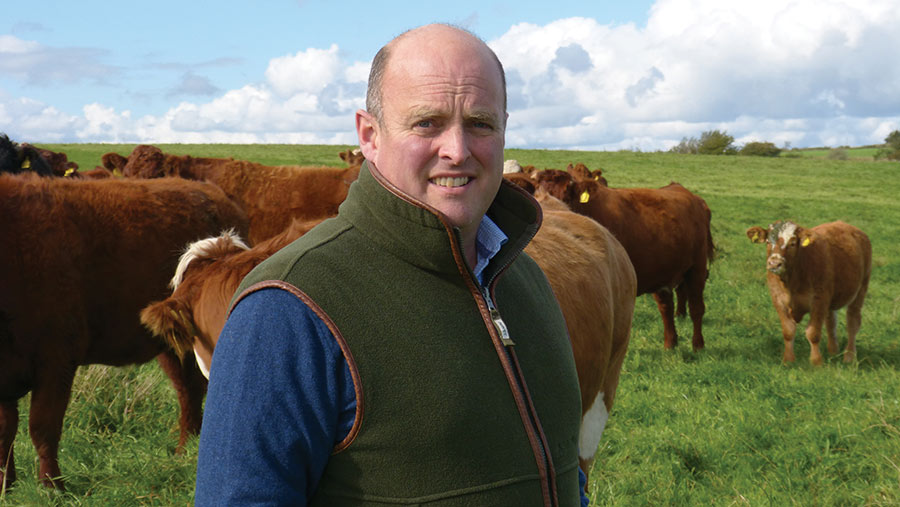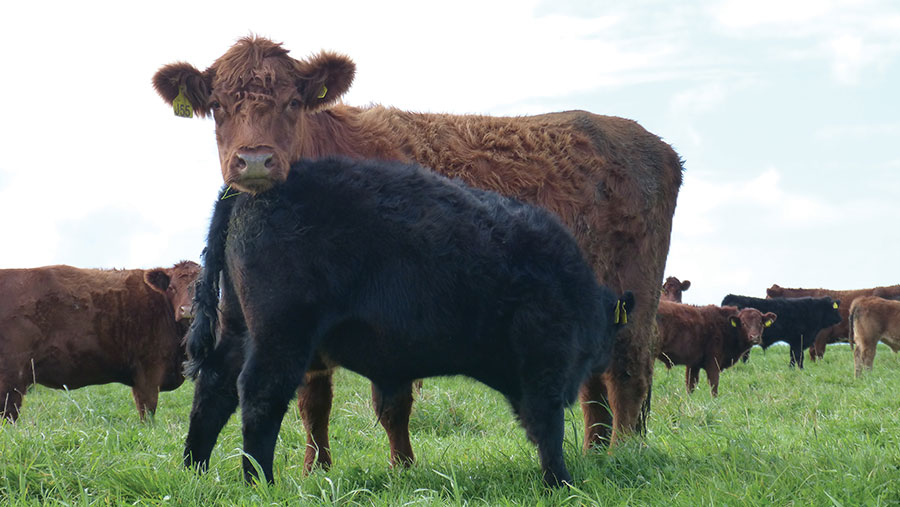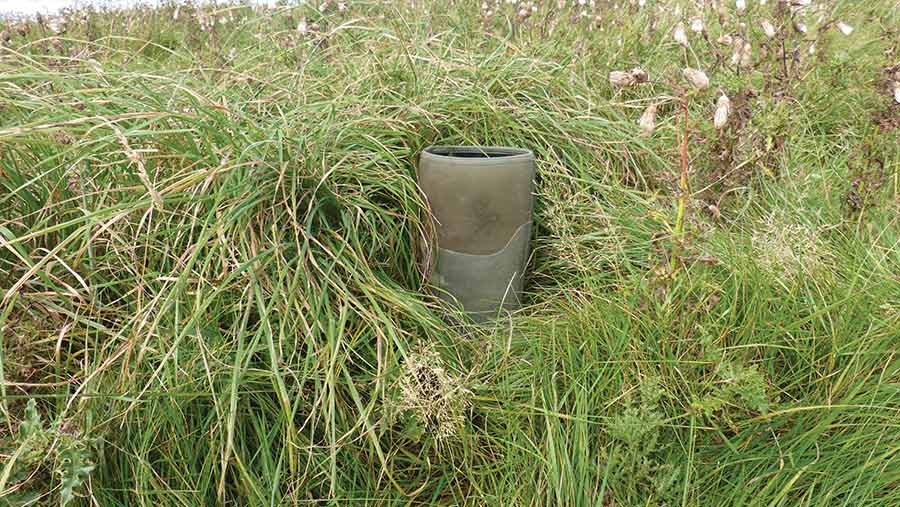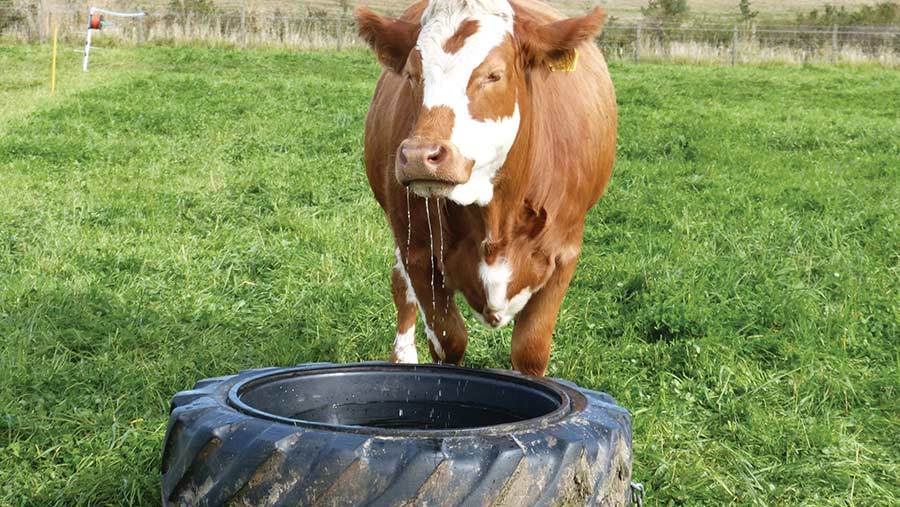Organic mob grazing system cuts £380/livestock unit on estate
 Sam Parsons and the Balcaskie team have made big changes © MAG/Michael Priestley
Sam Parsons and the Balcaskie team have made big changes © MAG/Michael Priestley A Scottish livestock operation has removed £200,000 of costs in an ambitious system rethink based on outwintering, forage finishing and soil health.
The Balcaskie Estate in Fife has adopted organic, mob grazing in an attempt to drastically cut costs and improve the businesses viability.
Five years ago, the estate manager Sam Parsons had a strategy meeting and realised change was vital.
“We looked back 50 years at what had happened to farming. We asked whether we could cope if subsidy payments halves and red meat lost 20% of its value – the answer at the time was, we couldn’t.”
See also: How beef herd is delivering £350/cow net profit with deferred, mob grazing
The team now manages the cows in a manner more akin to nature. They hope this will improve the soils and biodiversity on the estate.
This has been achieved by removing chemicals and synthetic fertiliser, mob grazing the cows and giving grassland longer rest periods. They also outwinter on deferred grass and bale graze to reduce winter housing costs.
“We looked back 50 years at what had happened to farming,” explains estate manager Sam Parsons. “We asked whether we could cope if subsidy payments halved and red meat lost 20% of its value – the answer at the time was, we couldn’t.”
Herd facts
- Balcaskie Estate is 1,660ha (4,500 acres) overall
- 1,295ha (3,200 acres) farmed in-hand by estate, of which 1,000ha is now grassland
- 350 suckler cows, including 100 pedigree Lincoln Reds
- Producing Pasture for Life beef
- 15% of Beef sold through Balcaskie brand, rest through Scotbeef
- 900 Scotch Mules and Greyfaced cross ewes put to terminal sires
Changes
It’s still early days for the estate’s evolving system, which is developing under the consultancy of ecologist and farmer Rob Harvard of Phepson Angus, Worcestershire.
The estate farm recently took 280ha of arable farmland back in hand. To rebuild fertility, 250ha of clover-rich herbal leys fix nitrogen in the soil and extend grazing at the shoulders of the season.
The estate will complete its organic conversion in 2022 after starting in 2016, when it began testing soil organic matter levels. The plan is that soil health will be built through integrating livestock in the arable rotation.
Sheep numbers have increased from 600-head to 900 and cow numbers have increased from about 320-head to 350. Roughly 1,500 ewes and 450 cows is the aim.
The farm previously ran 220 Simmental cross Luing cows and 100 Luing cows. Now the herd bulls everything with Lincoln Reds.
One-third of the herd is pedigree Lincoln Red and the Simmental genetics are being phased out to reduce mature cow size.
The plan is to reduce mature cow size by 100kg through this switch, taking average weights to about 650kg.
The farm experimented mob grazing 40 cows on the heaviest part of the farm in 2017, then 87 cows in 2018 and 100 last year.

Commercial cows are a Simmental cross Luing and all have been put to Lincoln Reds this year © MAG/Michael Priestley
Outwintering
Confidence grew last winter, when 87 cows were grazed on the wettest and least improved fields.
This year all cows will be outwintered on deferred grass with hay bales from January to March.
Two winter pastures will be drilled with spring milling wheat after cows have added the soil fertility for the arable enterprise.
Cows will be housed from 1 March to calve, as opposed to October, taking five months off the farm’s winter housing costs.
Cows are turned out as they calve in an eight-to-10-week block, which hasn’t changed. Some early calvers are only inside a few weeks.
Previously, the cows were set stocked. Now three cow mobs and one mob of yearlings graze 1ha (2.5 acre) paddocks (approximately) on 60-day rotations from late April to November.
About £8,000 of electric fencing, water pipes, drag troughs and ballcock troughs has been installed for the cows, with a little more still to be done.

An entire summer’s growth is built up on outwintering land to winter cattle cheaply for a 60-day period © MAG/Michael Priestley
Finishing
Weaned calves are still vaccinated for pneumonia and housed for winter on grass silage and straw.
Everything is sold under the Soil Association and Pasture for Life banner and is 100% forage-finished on grazed leys in December or silage and straw during winter. Previously, cattle were finished on a barley-based diet.
This has cost at least two months on days to slaughter, with cattle now being sold at 24-29 months as opposed to 20-26.
The system also weans a smaller calf and produces a carcass of about 320kg, while the previous system averaged about 350kg, with Simmentals up to 380kg.
“Spreading out finishing suits our end users, as they are hotels and restaurant who need a steady supply,” explains Mr Parsons. “Finishing will take longer but it’s more profitable. We’ve compared barley and beans to silage and straw and we make more margin on silage and straw.”
Including the sheep, the farm has 525 livestock units, the savings – which include labour, machinery running costs and depreciation – work out at £380/livestock unit.

Drag troughs are placed in forklift tyres to protect them and pulled by the quad bike on chains © MAG/Michael Priestley
Benefits
Improving soil health naturally in an organic system is a slow and steady process, but the team has already seen an increase in organic matter levels, faster water infiltration, better grass growth in dry springs and a longer grazing season.
Results are pending on a thorough soil GPS audit, which was done to give a rough idea of how soil has changed. Back in 2016 the farm took a baseline organic matter reading, which ranged from 2.3% to 18%.
Wildlife biodiversity is increasing, and more insects can be found in permanent pasture and herbal leys. Deferred grazing on the hill is reducing thistle and ragwort numbers as other grasses and flowers increase.
Some of the savings of the system change
- £80,000 a year saved on straw now the winter is shorter.
- Annual cost of running the feeder wagon (servicing, parts, labour and depreciation) for seven months was £56,000 and the bedding machine cost £36,000. Machinery time spent on cows has been reduced by 71%, which could double the life of the machinery.
- Five years ago, fertiliser cost was £1/kg liveweight, which has completely gone. The farm was spending up to £90,000 on fertiliser and a further £160,000/year on arable fertiliser.
- Mineral spend was at £14,000/year and has been cut to £1,000 on ewes pre-tupping and at lambing. Cattle receive no minerals but are blood tested throughout the season.
Soil testing at Balcaskie
- GPS soil analysis: The whole farm has been tested since 2008, analysing organic matter, nitrogen, phosphate, potassium, trace elements and pH annually. The farm is saving about £7/ha on the service as they no longer need the fertiliser spreading advice – it costs about £18/ha.
- Soil Association mob grazing field lab: The farm is a field lab which means it hosts farm walks and shares progress. It helps the Balcaskie team learn about soils and management through peer-to-peer learning
- Soil Mentor tests: Each summer the estate staff all have a competition to find the healthiest soil. Staff undertake an earthworm count, a slake test (ability to hold together in water), a visual evaluation of soil structure, and an infiltration rate test as a proxy for organic matter, soil structure and rooting depth.
The numbers
- 5: How many months of winter have been saved for the herd at Balcaskie
- 88-89%: Percentage of calves weaned for every 100 cows bulled, which hasn’t altered through the system change
- £17k: How much the Balcaskie Estate saved in cash costs by shortening the winter of 87 cows in 2019-20
- £195: Current total cost to winter a cow
